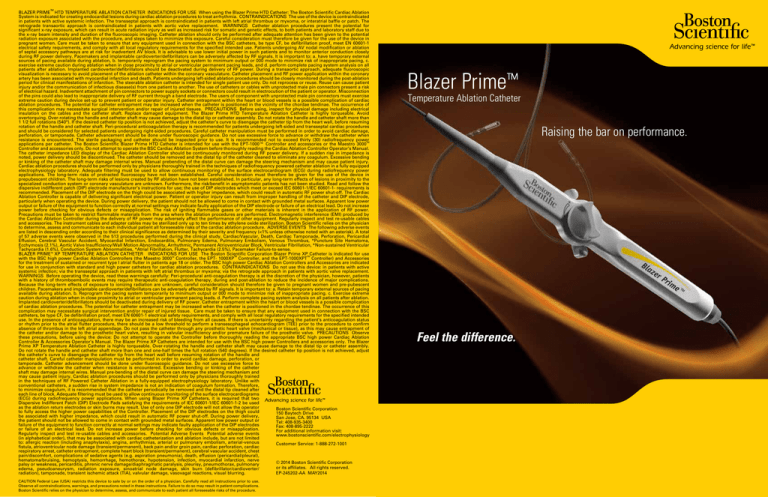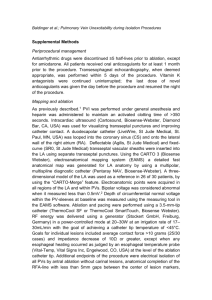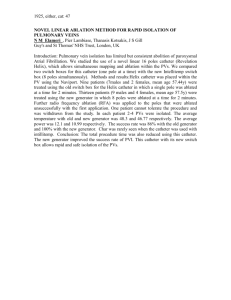
BLAZER PRIME™ HTD TEMPERATURE ABLATION CATHETER INDICATIONS FOR USE When using the Blazer Prime HTD Catheter: The Boston Scientific Cardiac Ablation
System is indicated for creating endocardial lesions during cardiac ablation procedures to treat arrhythmia. CONTRAINDICATIONS The use of the device is contraindicated
in patients with active systemic infection. The transseptal approach is contraindicated in patients with left atrial thrombus or myxoma, or interatrial baffle or patch. The
retrograde transaortic approach is contraindicated in patients with aortic valve replacement. WARNINGS Catheter ablation procedures present the potential for
significant x-ray exposure, which can result in acute radiation injury as well as increased risk for somatic and genetic effects, to both patients and laboratory staff due to
the x-ray beam intensity and duration of the fluoroscopic imaging. Catheter ablation should only be performed after adequate attention has been given to the potential
radiation exposure associated with the procedure, and steps taken to minimize this exposure. Careful consideration must therefore be given for the use of the device in
pregnant women. Care must be taken to ensure that any equipment used in connection with the BSC catheters, be type CF, be defibrillation proof, meet EN 60601-1
electrical safety requirements, and comply with all local regulatory requirements for the specified intended use. Patients undergoing AV nodal modification or ablation
of septal accessory pathways are at risk for inadvertent AV block. It is advisable to use lower initial power in such patients and to monitor anterior conduction closely
during RF power delivery. Pacemakers and implantable cardioverter/defibrillators can be adversely affected by RF signals. It is important to: a. have temporary external
sources of pacing available during ablation, b. temporarily reprogram the pacing system to minimum output or 000 mode to minimize risk of inappropriate pacing, c.
exercise extreme caution during ablation when in close proximity to atrial or ventricular permanent pacing leads, and d. perform complete pacing system analysis on all
patients after ablation. Implanted cardioverter/defibrillators should be deactivated during delivery of RF power. During a transaortic approach, adequate fluoroscopic
visualization is necessary to avoid placement of the ablation catheter within the coronary vasculature. Catheter placement and RF power application within the coronary
artery has been associated with myocardial infarction and death. Patients undergoing left-sided ablation procedures should be closely monitored during the post-ablation
period for clinical manifestations of infarction. The steerable ablation catheter is intended for single patient use only. Do not reprocess or reuse. Reuse can cause patient
injury and/or the communication of infectious disease(s) from one patient to another. The use of catheters or cables with unprotected male pin connectors present a risk
of electrical hazard. Inadvertent attachment of pin connectors to power supply sockets or connectors could result in electrocution of the patient or operator. Misconnection
of the pins could also lead to inappropriate delivery of RF current through a band electrode. The users of component with unprotected male pin connectors must exercise
extreme caution during device set-up to prevent patient or operator injury. Catheter entrapment within the heart or blood vessels is a possible complication of cardiac
ablation procedures. The potential for catheter entrapment may be increased when the catheter is positioned in the vicinity of the chordae tendinae. The occurrence of
this complication may necessitate surgical intervention and/or repair of injured tissues. PRECAUTIONS Before using, inspect for physical damage including electrical
insulation on the cables and the catheter shaft. Replace damaged equipment. The Blazer Prime HTD Temperature Ablation Catheter is highly torqueable. Avoid
overtorquing. Over-rotating the handle and catheter shaft may cause damage to the distal tip or catheter assembly. Do not rotate the handle and catheter shaft more than
1 1/2 full rotations (540°). If the desired catheter tip position is not achieved, adjust the catheter’s curve to disengage the catheter tip from the heart wall, before resuming
rotation of the handle and catheter shaft. Peri-procedural anticoagulation therapy is recommended for patients undergoing left-sided and transseptal cardiac procedures
and should be considered for selected patients undergoing right-sided procedures. Careful catheter manipulation must be performed in order to avoid cardiac damage,
perforation, or tamponade. Catheter advancement should be done under fluoroscopic guidance. Do not use excessive force to advance or withdraw the catheter when
resistance is encountered. The sterile packaging and catheter should be inspected prior to use. It is recommended not to exceed thirty (30) radiofrequency power
applications per catheter. The Boston Scientific Blazer Prime HTD Catheter is intended for use with the EPT-1000™ Controller and accessories or the Maestro 3000™
Controller and accessories only. Do not attempt to operate the BSC Cardiac Ablation System before thoroughly reading the Cardiac Ablation Controller Operator’s Manual.
The catheter impedance LED display of the Cardiac Ablation Controller should be continuously monitored during RF power delivery. If a sudden rise in impedance is
noted, power delivery should be discontinued. The catheter should be removed and the distal tip of the catheter cleaned to eliminate any coagulum. Excessive bending
or kinking of the catheter shaft may damage internal wires. Manual prebending of the distal curve can damage the steering mechanism and may cause patient injury.
Cardiac ablation procedures should be performed only by physicians thoroughly trained in the techniques of radiofrequency powered catheter ablation in a fully equipped
electrophysiology laboratory. Adequate filtering must be used to allow continuous monitoring of the surface electrocardiogram (ECG) during radiofrequency power
applications. The long-term risks of protracted fluoroscopy have not been established. Careful consideration must therefore be given for the use of the device in
prepubescent children. The long-term risks of lesions created by RF ablation have not been established. In particular, any long-term effects of lesions in proximity to the
specialized conduction system or coronary vasculature are unknown. Furthermore, the risk/benefit in asymptomatic patients has not been studied. Read and follow the
dispersive indifferent patch (DIP) electrode manufacturer’s instructions for use; the use of DIP electrodes which meet or exceed IEC 60601-1/IEC 60601-1- requirements is
recommended. Placement of the DIP electrode on the thigh could be associated with higher impedance, which could result in automatic RF power shut-off. The Cardiac
Ablation Controller is capable of delivering significant electrical power. Patient or operator injury can result from improper handling of the catheter and DIP electrode,
particularly when operating the device. During power delivery, the patient should not be allowed to come in contact with grounded metal surfaces. Apparent low power
output or failure of the equipment to function correctly at normal settings may indicate faulty application of the DIP electrode or failure of an electrical lead. Do not increase
power before checking for obvious defects or misapplication. The risk of igniting flammable gases or other materials is inherent in the application of RF power.
Precautions must be taken to restrict flammable materials from the area where the ablation procedures are performed. Electromagnetic interference (EMI) produced by
the Cardiac Ablation Controller during the delivery of RF power may adversely affect the performance of other equipment. Regularly inspect and test re-usable cables
and accessories. The instrument cables and adapter cables may be sterilized only up to ten times by ethylene oxide sterilization. Boston Scientific relies on the physician
to determine, assess and communicate to each individual patient all foreseeable risks of the cardiac ablation procedure. ADVERSE EVENTS The following adverse events
are listed in descending order according to their clinical significance as determined by their severity and frequency (<1% unless otherwise noted with an asterisk). A total
of 57 adverse events were observed in the 513 procedures performed during the clinical study. Cardiac/Vascular, Death, Cardiac Tamponade, Perforation, Pericardial
Effusion, Cerebral Vascular Accident, Myocardial Infarction, Endocarditis, Pulmonary Edema, Pulmonary Embolism, Venous Thrombus, *Puncture Site Hematoma,
Ecchymosis (2.1%), Aortic Valve Insufficiency/Wall Motion Abnormality, Arrhythmic, Permanent Atrioventricular Block, Ventricular Fibrillation, *Non-sustained Ventricular
Tachycardia (1.6%), Conduction System Abnormalities, *Atrial Fibrillation, Flutter, Tachycardia (2.5%), Pacemaker Failure-to-sense.
BLAZER PRIME™ XP TEMPERATURE ABLATION CATHETER INDICATIONS FOR USE The Boston Scientific Corporation Blazer Prime XP Catheter is indicated for use
with the BSC high power Cardiac Ablation Controllers (the Maestro 3000™ Controller, the EPT- 1000XP™ Controller, and the EPT-1000XPT™ Controller) and Accessories
for the treatment of sustained or recurrent type I atrial flutter in patients age 18 or older. The BSC high power Cardiac Ablation Controllers and Accessories are indicated
for use in conjunction with standard and high power catheters for cardiac ablation procedures. CONTRAINDICATIONS Do not use this device: in patients with active
systemic infection; via the transseptal approach in patients with left atrial thrombus or myxoma; via the retrograde approach in patients with aortic valve replacement.
WARNINGS Before operating the device, read these warnings carefully: Peri-procedural anti-coagulation therapy is at the discretion of the physician, however, patients
with a history of thromboembolic events may require therapeutic anti-coagulation therapy, during and post-ablation to reduce the incidence of major complications.
Because the long-term effects of exposure to ionizing radiation are unknown, careful consideration should therefore be given to pregnant women and pre-pubescent
children. Pacemakers and implantable cardioverter/defibrillators can be adversely affected by RF signals. It is important to: a. Retain temporary external sources of pacing
available during ablation. b. Reprogram the pacing system temporarily to minimum output or 000 mode to minimize risk of inappropriate pacing. c. Exercise extreme
caution during ablation when in close proximity to atrial or ventricular permanent pacing leads. d. Perform complete pacing system analysis on all patients after ablation.
Implanted cardioverter/defibrillators should be deactivated during delivery of RF power. Catheter entrapment within the heart or blood vessels is a possible complication
of cardiac ablation procedures. The potential for catheter entrapment may be increased when the catheter is positioned in the chordae tendinae. The occurrence of this
complication may necessitate surgical intervention and/or repair of injured tissue. Care must be taken to ensure that any equipment used in connection with the BSC
catheters, be type CF, be defibrillation proof, meet EN 60601-1 electrical safety requirements, and comply with all local regulatory requirements for the specified intended
use. In the presence of anticoagulation, there may be an increased risk of bleeding from all causes. If there is uncertainty regarding the patient’s anticoagulation status
or rhythm prior to the atrial flutter procedure, there should be a low threshold to perform a transesophageal echocardiogram (TEE) prior to the procedure to confirm
absence of thrombus in the left atrial appendage. Do not pass the catheter through any prosthetic heart valve (mechanical or tissue), as this may cause entrapment of
the catheter and/or damage to the prosthetic heart valve, resulting in valvular insufficiency and/or premature failure of the prosthetic valve. PRECAUTIONS Observe
these precautions, before using the device: Do not attempt to operate the Controller before thoroughly reading the appropriate BSC high power Cardiac Ablation
Controller & Accessories Operator’s Manual. The Blazer Prime XP Catheters are intended for use with the BSC high power Controllers and accessories only. The Blazer
Prime XP Temperature Ablation Catheter is highly torqueable. Over-rotating the handle and catheter shaft may cause damage to the distal tip or catheter assembly.
Do not rotate the handle and catheter shaft more than one and one-half times the full rotation (540 degrees). If the desired catheter tip position is not achieved, adjust
the catheter’s curve to disengage the catheter tip from the heart wall before resuming rotation of the handle and
catheter shaft. Careful catheter manipulation must be performed in order to avoid cardiac damage, perforation, or
tamponade. Catheter advancement should be done under fluoroscopic guidance. Do not use excessive force to
advance or withdraw the catheter when resistance is encountered. Excessive bending or kinking of the catheter
shaft may damage internal wires. Manual pre-bending of the distal curve can damage the steering mechanism and
may cause patient injury. Cardiac ablation procedures should be performed only by physicians thoroughly trained
in the techniques of RF Powered Catheter Ablation in a fully-equipped electrophysiology laboratory. Unlike with
conventional catheters, a sudden rise in system impedance is not an indication of coagulum formation. Therefore,
to minimize coagulum, it is recommended that the catheter periodically be removed and the distal tip cleaned after
each line of block. Adequate filtering must be used to allow continuous monitoring of the surface electrocardiograms
(ECG) during radiofrequency power applications. When using Blazer Prime XP Catheters, it is required that two
Dispersive Indifferent Patch (DIP) Electrode Pads satisfying the requirements of IEC 60601-1/IEC 60601-1-2 be used
as the ablation return electrodes or skin burns may result. Use of only one DIP electrode will not allow the operator
Boston Scientific Corporation
to fully access the higher power capabilities of the Controller. Placement of the DIP electrodes on the thigh could
150 Baytech Drive
be associated with higher impedance, which could result in automatic RF power shut-off. During power delivery,
San Jose, CA. 95134 USA
the patient should not be allowed to come in contact with grounded metal surfaces. Apparent low power output or
Tel: 408-935-3400
failure of the equipment to function correctly at normal settings may indicate faulty application of the DIP electrodes
Fax: 408-895-2222
or failure of an electrical lead. Do not increase power before checking for obvious defects or misapplication.
For additional information visit:
Regularly inspect and test re-usable cables and accessories. Potential Adverse Events Potential adverse events
www.bostonscientific.com/electrophysiology
(in alphabetical order), that may be associated with cardiac catheterization and ablation include, but are not limited
to: allergic reaction (including anaphylaxis), angina, arrhythmias, arterial or pulmonary embolism, arterial-venous
Customer Service: 1-888-272-1001
fistula, atrioventricular node damage (transient/permanent), back pain and/or groin pain, cardiac perforation, cardiac
respiratory arrest, catheter entrapment, complete heart block (transient/permanent), cerebral vascular accident, chest
pain/discomfort, complications of sedative agents (e.g. aspiration pneumonia), death, effusion (pericardial/pleural),
hematoma/bruising, hemoptysis, hemorrhage, hemothorax, hypotension, infection, myocardial infarction, nerve
© 2014 Boston Scientific Corporation
palsy or weakness, pericarditis, phrenic nerve damage/diaphragmatic paralysis, pleurisy, pneumothorax, pulmonary
or its affiliates. All rights reserved.
edema, pseudoaneurysm, radiation exposure, sinoatrial node damage, skin burn (defibrillator/cardioverter/
EP-245202-AA MAY2014
radiation), tamponade, transient ischemic attack (TIA), valvular damage, vasovagal reactions, visual blurring.
CAUTION Federal Law (USA) restricts this device to sale by or on the order of a physician. Carefully read all instructions prior to use.
Observe all contraindications, warnings, and precautions noted in these instructions. Failure to do so may result in patient complications.
Boston Scientific relies on the physician to determine, assess, and communicate to each patient all foreseeable risks of the procedure.
Blazer Prime™
Temperature Ablation Catheter
Raising the bar on performance.
Feel the difference.
Blazer Prime™ Temperature Ablation Catheter – Intuitively engineered for exceptional performance.
Better Torqueability
Performance
always matters.
1
Extra support in proximal shaft is designed to:
•improves the “push” response from catheter handle to tip
•contribute to better overall torque of the catheter
The Blazer Prime Catheter
raises the bar on ablation
catheter performance.
Left Side Accessory Pathway
Intuitively engineered
Better Trackability
construction combined
with our trusted Blazer
Better Tip Stability & Durability
­ moother transition from distal tip
S
to proximal shaft is designed to:
•navigate smoothly through complex
anatomy
•aid banking maneuvers
3
Catheter platform provide
an ablation catheter
designed to function as
a physical extension of
AVNRT
your hand. Manipulation
Fiber-reinforced distal section and more rugged
center support provide flexible strength to
optimize tip control and durability:
•improves lateral contact strength
•increases back steering strength
•enhances distal torque
2
RVOT
of the handle translates
predictably into movement
of the catheter tip. Control
and durability provide
procedural confidence.
Atrial Flutter
1 Distal torque bench testing compared Blazer Prime and Blazer™ II HTD temperature ablation catheters. Bench testing performed by Boston Scientific.
N=5. Data on file. Bench testing not necessarily predictive of clinical outcomes.
2 Catheter stiffness profile/3-point bend bench testing compared Blazer Prime and Blazer II HTD temperature ablation catheters. Bench testing performed by Boston Scientific. N=5. Data on file. Bench testing not necessarily predictive of clinical outcomes.
3 Curve retention/curve angle degradation bench testing compared Blazer Prime and Blazer II HTD temperature ablation catheters. Bench testing performed by Boston Scientific. N=5. Data on file. Bench testing not necessarily predictive of clinical outcomes. ­
Feel the difference.




